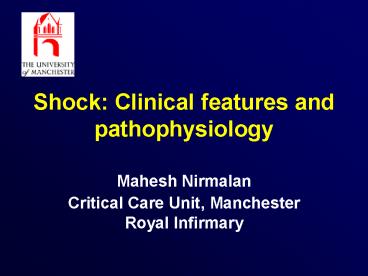Shock: Clinical features and pathophysiology - PowerPoint PPT Presentation
1 / 35
Title:
Shock: Clinical features and pathophysiology
Description:
Shock: Clinical features and pathophysiology Mahesh Nirmalan Critical Care Unit, Manchester Royal Infirmary Objectives Life-threatening condition Immediate or delayed ... – PowerPoint PPT presentation
Number of Views:697
Avg rating:3.0/5.0
Title: Shock: Clinical features and pathophysiology
1
Shock Clinical features and pathophysiology
- Mahesh Nirmalan
- Critical Care Unit, Manchester Royal Infirmary
2
Objectives
- Life-threatening condition
- Immediate or delayed mortality
- Multiple aetiology
- Recognition and Assessment
- Physiological consequences of shock
- clinical features
- Document and report on progression
3
Definition of Shock
- Inadequate tissue perfusion
- Decreased oxygen supply
- Anaerobic metabolism
- Accumulation metabolic waste
4
Causes of Shock
- Severe or sudden blood loss
- Large drop in body fluids
- Myocardial infarction
- Major infections
- High spinal injuries
- Anaphylaxis
- Extreme heat or cold
5
Types of Shock
- Hypovolemic Shock
- haemorrhagic
- or non haemorrhagic
- Other causes of shock
- Cardiogenic Shock
- Septic Shock
- Neurogenic Shock
- Anaphylactic Shock
6
Harvest of Death T H OSullivan
7
Hypovolaemic Shock
- Haemorrhage Overt or occult
- Reduction in circulating volume
- Reduction in venous return and CO
- O2 supply-demand imbalance
- Lactic acidosis
- Reduction in venous oxygen saturation
- Non haemorrhagic hypovolaemia
- Severe burns, vomiting and diarrhoea
8
CO, MAP and SvO2
9
Effect of EDV and contractility on SV
10
Changes in CO and MAP in haemorrhage
11
Clinical Signs of Acute Hemorrhagic Shock
12
Signs of Shock
- Cold, clammy and pale skin
- Rapid, weak, thready pulse
- Shallow, rapid breathing
- Oliguria
- Reduction in MAP
- Cyanosis
- Loss of consciousness
13
Non-Haemorrhagic Shock
- Cardiogenic Shock
- Septic Shock
- Neurogenic Shock
- Anaphylactic Shock
14
Cardiogenic Shock
- Primary myocardial failure
- Arrhythmia
- Tamponade
- Contusion
- Pump failure
- Reduction in cardiac output
- Decreased blood supply
- Decreased oxygen delivery
15
Cardiogenic Shock
- Assess for
- Signs of heart failure
- Signs of tamponade
- Cardiac dysrrhythmia
- Myocardial infarction
- Tachycardia
- Muffled heart sounds or third heart sound
- Engorged neck veins with hypotension
- Dyspnoea
- Oedema in feet and ankles
16
Septic Shock
- Bacterial, viral, fungal infection
- Gram negative and gram positive bacteria
- High output failure warm shock
- Fever, tachycardia, tachypnoea, leucocytosis
- Inadequate oxygen extraction
- High SvO2, Metabolic acidosis
- Cold shock
- Atypical presentation in immuno-compromised
patients - Diabetes, Cirrhosis, immunosuppression
17
Septic Shock in trauma patients
- Develops 2 - 5 days after injury occurs
- Carries a poor prognosis
- Assess for
- Penetrating abdominal injuries
- Signs of infection
- Warm pink skin and dry elevated body temperature
- Tachycardia
- Wide pulse pressures
18
Neurogenic Shock
- Caused by
- Spinal cord injury
- Certain drugs
- Brain stem, spinal or torso trauma
- Venous pooling and arteriolar dilatation
- Signs and Symptoms
- Hypotension without tachycardia
- Warm pink skin
- Low blood pressure minimal response to fluids
19
Anaphylactic shock
20
Anaphylactic Shock
- Rapid onset
- Primary systems
- Cardiovascular, Respiratory
- Skin, Gastrointestinal, coagulation
- Face, pharynx and laryngeal oedema
- Adrenaline is life saving
21
Anaphylactic Shock
- Diffuse vasodilatation
- Increase size of vascular bed
- Blood is trapped in small vessels and viscera
- Temporary loss in total circulatory volume
- Sudden severe allergic reaction to
- Drugs, Toxins, Foods, Plants
22
Symptoms
- Apprehension and flushing
- Wheezing or shortness of breath cough
- Rapid, weak pulse
- Cyanosis
- Generalized itching or burning
- Watering and itching of the eyes
- Hypotension
- Coma
23
Stages of shock
- Compensated shock
- Autotransfusion
- Decompensated shock
- Blood moves to more vital organs
- Irreversible shock
- Multiple system / organ damage
- Even with treatment, death is the result
24
Plasma Lactate
A priori groups
Post hoc groups
25
Evaluation of Shock
- Internal or external hemorrhage
- Underlying cardiac problems
- Sepsis
- Trauma to spine cord
- Contact with known allergic substance
- Determine amount of blood loss
- How long has casualty been bleeding?
26
Level of Consciousness
- Report and record
- Alert
- Verbal response to stimuli
- Pain response to stimuli
- Unresponsive to any stimuli
27
Early Signs of Shock in Non Complicated Patients
- High index of suspicion
- Minimum tachycardia
- No measurable changes occur in blood pressure
- Pulse pressure is potentially very useful
28
Definitive management
- Where?
- By whom?
29
Invasive monitoring
- Essential in the definitive treatment
- Direct arterial pressure
- Central venous pressure
- Cardiac output
30
Direct arterial pressure
31
CVP AND CIRCULATING VOLUME?
32
Treatment of Shock
Increase tissue perfusion and oxygenation status
- Maintain airway
- Control bleeding
- Baseline vital signs
- Level of consciousness
33
Treatment of Shock
- Positioning
- ABCD approach
- Fluid therapy
- Drug therapy
- Keep patient at normal temperature
- Prevent hypothermia
- Minimize effect of shock
- On-going assessment - every 10-15 minutes
34
Specific measures
- Hypovolaemia Blood transfusion
- Electrolyte/acid base imbalance
- Sepsis Antibiotics, ?steroids
- Neurogenic Steroids
- Anaphylactic Adrenalin
35
Summary
- Life threatening Early goal directed therapy and
regular monitoring by trained staff will change
outcome. - Early detection DONT RELY ON BP
- High index of suspicion
- Monitor casualties susceptible to shock

